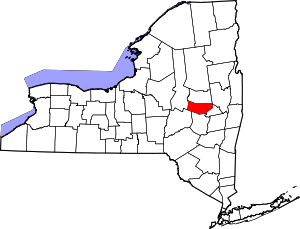Fort Hunter, New York
Fort Hunter is a hamlet in the town of Florida in Montgomery County, New York, on the north bank of the Mohawk River at Schoharie Creek.
In the 18th century, Fort Hunter was built as a fort near the location of one of the two primary Mohawk settlements. The Mohawk name for the village was rendered variously in English as Teantontalago, Thienderego, Tionondorage, and Tiononderoga. The European colonists called it the Lower Mohawk Castle. Canajoharie, the other primary Mohawk village, was known as the Upper Mohawk Castle and was located on the south side of the Mohawk River. The Dongan Charter gave the city of Albany the right to own 1,000 acres (4.0 km2) at the Lower Mohawk Castle.
One of its sachems, Hendrick Tejonihokarawa or Hendrick Peters of the Wolf Clan, was one of the "Four Mohawk Kings" who went to London in 1710 to meet with Queen Anne. The chiefs asked her for Anglican missionaries to help offset French Catholic influence in the Iroquois Confederacy, as well as defenses against French soldiers. In 1711, the Crown authorized the construction of Fort Hunter near Tionondorage. The fort contained a chapel and mission house. Queen Anne donated a set of communion silver and sent two missionaries to the colony.
In return, she had asked Tejonihokarawa for help in settling Palatine German refugees then working at English camps in the Hudson Valley. Through Governor Hunter, he made some Mohawk land available to settlers near Schoharie Creek, where some of the Palatines eventually settled.[1]
Fort Hunter land, at the mouth of the Schoharie on both sides, (approximately 80 acres) was deeded in 1697, to Jan Peterse Mabee because his wife Anna Borsboom, was "something related to the Indian castle". It was signed by Sachem Rode, of the Wolf Clan. There was later a land swap, in order to build the Fort in 1710, with the Mabee family receiving land further south on the Schoharie Creek. There is a copy of the deed, both in the Albany State Archives, and at the shrine of Kateri Tekakwitha.
Fort Hunter is now the site of the Schoharie Crossing State Historic Site, which has the remains of the Schoharie Crossing aqueduct and part of a lock from the early nineteenth-century development of the Erie Canal.
References
- ↑ Snow, Dean R. "Searching for Hendrick: Correction of a Historic Conflation". New York History, Summer 2007
External links
- "Fort Hunter", Tryon County, NY at Rootsweb
| |||||||||||||||||||||||||||||
Coordinates: 42°56′32″N 74°17′06″W / 42.94222°N 74.28500°W
